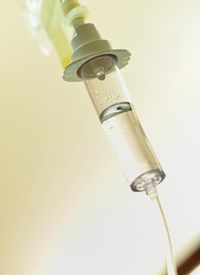Location, Location, Location: Red Box Eases Anxiety in the Infusion Room
As presented at the 2017 ONS Annual Congress, nurses at Cancer Treatment Centers of America at Eastern Medical Center developed an emergency supply box for the occurrence of hypersensitivity reactions during cancer therapy infusions.
Location, Location, Location: Red Box Eases Anxiety in the Infusion Room

Hypersensitivity reactions are an ongoing concern during cancer therapy infusions, and nurses are always on the lookout for early signs that their patients may be having one. It turns out that having an emergency supplies box nearby can make this process much less stressful for nurses—and their patients.
Nurses at Cancer Treatment Centers of America at Eastern Medical Center (CTCA-Eastern), led by Carolyn Ruef, MSN, CRNP, AOCNP, introduced an emergency “Red Box” in 3 areas within its large infusion room. The findings of their project were presented during a poster session at the 42nd Annual ONS Congress being held May 4-7 in Denver, Colorado.
In an interview with Oncology Nursing News, Ruef’s colleague at CTCA-Eastern, Eileen Eisenhower, RN, BSN, CRNI, OCN, explained that the box has been through multiple revisions since the idea was first piloted in 2013. However, now—thanks to Ruef—it’s the size of a tackle box, big enough to hold all of the supplies needed when a patient first shows signs of a hypersensitivity reaction, among them, saline, tubing, methylprednisolone (eg, Solu-medrol), Benadryl, Pepcid, Demerol, IV start kits, and an Epi pen.
Eisenhower explained that previously, if a patient showed symptoms of a reaction, the nurse would stop the infusion and then had to go some distance to the med room. “When there’s a reaction, your adrenalin is running, and trying to remember the code to get into the med room and grab the right supplies … All of that took more time than we were comfortable with, and it created some anxiety.”
And, “although we thought we were very good at catching even subtle signs of a reaction quickly,” she continued, “we really wanted to make that time between reaction and treatment shorter.”
Eisenhower explained that if a patient’s reaction progresses and is not treated quickly, respiratory arrest can follow: “We would have to get additional help from a rapid response team coming from other parts of the hospital.” Since the Red Box, there is less utilization of the Rapid Response System at CTCA.
Addressing an infusion reaction promptly also can also mean better patient outcomes because the drug may be reintroduced. When able to intervene early before more serious complications arise, “We can talk with the doctor, explain the symptoms, the patient feels better, and then [when appropriate] we can re-challenge them.”
Eisenhower said the Red Box could easily be deployed in other hospital departments, because there’s nothing in it that any other nurse wouldn’t use.
She credits Ruef for taking their team’s initial effort to a whole new level. “She made us dig deeper to really think about what we needed to make it much more useful.”
Now, with the box, “We feel much more in control, we feel much more comfortable, and prepared to treat any reaction that may come up.” And, importantly, “Patients also feel more comfortable; with a new treatment, they may be very nervous, and we can reassure them that if anything happens, we’ll treat it, and we have all the supplies right here.”
The contents of the Red Box align with CTCA’s Adverse Drug Reaction Protocol, which is based on recommendations of ONS, the Infusion Nursing Society, and Up to Date®.
Right now, says Eisenhower, the box contains what it needs, but as new treatments move into clinical practice, more items may be needed.
“It’s a wonderful tool to have, and it really does decrease everyone’s anxiety."



